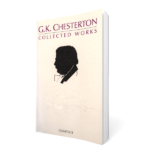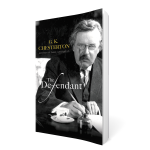In this age of child-psychology nobody pays any attention to the actual psychology of the child. All that seems to matter is the psychology of the psychologist and the particular theory or train of thought that he is maintaining against another psychologist. Most of the art and literature now magnificently manufactured for children is not even honestly meant to please children. The artist would hardly condescend to make a baby laugh if nobody else laughed, or even listened. These things are not meant to please the child. At best they are meant to please the child-lover. At the worst they are experiments in scientific educational method. Beautiful, wise, and witty lyrics like those of Stevenson’s “Child’s Garden of Verses” will always remain as a pure lively fountain of pleasure–for grown up people. But the point of many of them is not only such that a child could not see it, it is such that a child ought not to be allowed to see it—
The child that is not clean and neat,
With lots of toys and things to eat,
He is a naughty child, I’m sure,
Or else his dear papa is poor.
No child ought to understand the appalling abyss of that after-thought. No child could understand, without being a snob or a social reformer or something hideous, the irony of that illusion to the inequalities and iniquities with which this wicked world has insulted the sacred dignity of fatherhood. The child who could really smile at that line would be capable of sitting down immediately to write a Gissing novel, and then hanging himself on the nursery bed-post. But neither Stevenson or any Stevensonian (and I will claim to be a good Stevensonian) ever really dreamed of expecting a child to smile at the poem. It was the poet who smiled at the child, which is quite a different thing, though possibly quite as beautiful in its way. And that is the character of all this new nursery literature. It has the legitimate and even honourable object of educating the adult in the appreciation of babies. It is an excellent thing to teach men and women to take pleasure in children, but it is a totally different thing from giving children pleasure.
Now the old nursery rhymes were honestly directed to give children pleasure. Many of them have genuine elements of poetry, but they are not primarily meant to be poetry, because they are simply meant to be pleasure. In this sense “Hey Diddle Diddle” is something much more than an idyll. It is a masterpiece of psychology, a classic and perfect model of education. The lilt and jingle of it is exactly the sort that a baby can feel to be a tune and can turn into a dance. The imagery of it is exactly what is wanted for the first movements of imagination when it experiments in incongruity. For it is full of familiar objects in fantastic conjunction. The child has seen a cow and he has seen the moon. But the notion of the one jumping over the other is probably new to him and is, in the noblest word, nonsensical. Cats and dogs and dishes and spoons are all his daily companions and even his friends, but it gives him a sort of fresh surprise and happiness to think of their going on such a singular holiday. He would simply learn nothing at all from our attempts to find a fine shade of humour in the political economy of the poor papa, even if the poor papa were romantically occupied, not in jumping over the moon, but at least in shooting it.
Of course there is much more than this in “Hey Diddle Diddle.” The cow jumping over the moon is not only a fancy very suitable to children, it is a theme very worthy of poets. The lunar adventure may appear to some a lunatic adventure, but it is one round which the imagination of man has always revolved, especially the imagination of romantic figures like Ariosto, and Cyrano de Bergerac. The notion that cattle might fly has received sublime imaginative treatment. The winged bull not only walks, as if shaking the earth, amid the ruins of Assyrian sculpture, but even wheeled and flamed in heaven as the Apocalyptic symbol of St. Luke. That which combines imaginations so instinctive and ancient, in a single fancy so simple and so clear, is certainly not without the raw material of poetry. And the general idea, which is that of a sort of cosmic Saturnalia or season when anything may happen, is itself an idea that has haunted humanity in a hundred forms, some of them exquisitely artistic forms.
It would be easy to justify a vast number of the other nursery rhymes, in the same vein of a more serious art criticism. If I were asked to quote four lines which sufficed to illustrate what has been called the imaginative reason, when it rises almost to touch an unimaginative unreason (for that point of contact is poetry), I should be content to quote four lines that were in a picture book in my own nursery–
The man in the wilderness asked of me,
How many strawberries grow in the sea?
I answered him, as I thought good:
“As many red herrings as grow in the wood.”
Everything in that is poetical; from the dark unearthly figure of the man of the desert, with his mysterious riddles, to the perfect blend of logic and vision which makes beautiful pictures even in proving them impossible. But this artistic quality, though present, is not primary; the primary purpose is the amusement of children. And we are not amusing children; we are amusing ourselves with children.
Our fathers added a touch of beauty to all practical things, so they introduced fine fantastic figures and capering and dancing rhythms, which might be admired even by grown men, into what they primarily and practically designed to be enjoyed by children. But they did not always do this and they never thought mainly of doing it. What they always did was to make fun fitted for the young; and what they never did was turn it into irony only intelligible to the old. A nursery rhyme was like a nursery table or a nursery cupboard–a thing constructed for a particular human purpose. They saw their aim clearly and they achieved it. They wrote utter nonsense and took care to make it utterly nonsensical.
For there are two ways of dealing with nonsense in this world. One way is to put nonsense in the right place; as when people put nonsense into nursery rhymes. The other is to put nonsense in the wrong place; as when they put it into educational addresses, psychological criticisms, and complaints against nursery rhymes or other normal amusements of mankind.


